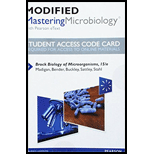
Concept explainers
Bacteria are prokaryotic microorganism. They can grow and live in various environments like soil, ocean, inside rocks and animals. Some bacteria are involved in symbiotic relationships and others may cause serious health problems to humans and animals. Gram-negative bacteria use secretion systems (types I to VI) to insert substances or effector molecules (proteins, toxins, or enzymes) into their outer membranes or secrete substances outside of the gram-negative bacterial cell. Type I to VI secretion systems in gram-negative bacteria facilitate various biological activities such as symbiotic interactions, extracellular enzyme secretion, biofilm formation, release of antibiotics, DNA transfer, and transfer of protein molecules into host cells. Secreted substances by secretion systems help the interaction of bacterial with other organisms or their environment.
Want to see the full answer?
Check out a sample textbook solution
Chapter 4 Solutions
Modified Mastering Microbiology with Pearson eText -- Standalone Access Card -- for Brock Biology of Microorganisms (15th Edition)
- If the gene undergoing protein synthesis consists of 24 bases, how many codons does that result in? How many amino acids will the protein consist of?arrow_forwardWhat mutagen causes thymine dimers, and why does it kill cells?arrow_forwardWhat is the mRNA transcript for the DNA sequence TTA CGC?arrow_forward
- If an extra nucleotide is inserted in the first exon of the beta globin gene, what effect will it have on the amino acid sequence of the globin polypeptides? Will the globin most likely be fully functional, partly functional, or nonfunctional? Why?arrow_forwardWhat is nucleosome supercoiling?arrow_forwardWhat are the major factors in the various mutants of the spike protein?arrow_forward
- What mutations are possible in gene ZFPM2?arrow_forwardWhat three different types of mutations involve changes in a single base, and what effect can each of them have on a coding sequence? Which type is the most common? Which type has the most severe effect on the function of the encoded protein?arrow_forwardwhich exons become spliced together?arrow_forward
 Human Heredity: Principles and Issues (MindTap Co...BiologyISBN:9781305251052Author:Michael CummingsPublisher:Cengage Learning
Human Heredity: Principles and Issues (MindTap Co...BiologyISBN:9781305251052Author:Michael CummingsPublisher:Cengage Learning Principles Of Radiographic Imaging: An Art And A ...Health & NutritionISBN:9781337711067Author:Richard R. Carlton, Arlene M. Adler, Vesna BalacPublisher:Cengage Learning
Principles Of Radiographic Imaging: An Art And A ...Health & NutritionISBN:9781337711067Author:Richard R. Carlton, Arlene M. Adler, Vesna BalacPublisher:Cengage Learning

